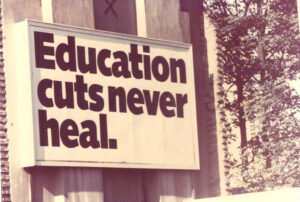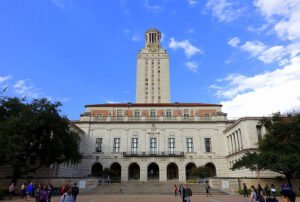August 24, 2015; Inside Higher Ed
Few experts question the need for basic education as a way to palliate social ills. Education is considered a primary way to overcome all sorts of social problems, from extreme poverty to health literacy.
While no one would question the need for the ABC’s, the benefits of higher education are where things get murky. At a time of “qualification inflation,” when highly educated people are working at coffee bars to pay off fancy degrees, is free online education the answer to both relieving debt and improving lives through education?
In this area, NPQ has covered for-profit and nonprofit universities, the role of universities as theoretical think tanks or job-readiness factories, and models for lowering college tuition. All of these issues relate to the overall questions of public and private benefits of higher education, who should access it, and for how much.
A recent model of nearly-free education is University of the People, an online institution based in California. As reported by Inside Higher Ed, the University of the People was accredited by the Distance Education and Training Council (now called the Distance Education Accrediting Commission) in 2014. This nonprofit’s main goal is to help refugees and immigrants get that vital piece of paper for their resumes. While tuition is free, students do have to pay for end-of-course exams.
“In the six years since University of the People was established, that idea and mission have taken off. After achieving accreditation a year ago, University of the People has seen interest in the degree programs skyrocket. Currently they have about 300 students waiting for scholarships to attend the online institution,” says Shai Reshef, president of the university.
This close-to-free online model has caught the rising wave of massive open online courses (MOOCs), such as edX and Coursera, which are channels for international heavyweights like Harvard and Johns Hopkins to reach more students. For the most part, however, online education still doesn’t carry a lot of weight.
Sign up for our free newsletters
Subscribe to NPQ's newsletters to have our top stories delivered directly to your inbox.
By signing up, you agree to our privacy policy and terms of use, and to receive messages from NPQ and our partners.
The Inside Higher Ed article downplays the stigma of online education and the fact that many students perceive these courses as easy credit. The article addresses this sticky point in passing, with just a short quote from a student who “learned despite underestimating the quality of the work [that] he wasn’t going to be able to coast through the program.”
MOOCs nevertheless remain a viable way to provide low-cost education, which has become a hot-button political issue. Recent examples of this are President Barack Obama’s two-year college proposal to reduce community college tuition to zero and Hillary Clinton’s New College Compact to make college and university more affordable for families suffocating under education-related debt, which now surpasses U.S. credit card debt.
But does “free” actually motivate students to learn? In a recent Forbes article, John Ebersole, president of the nonprofit Excelsior College, offered the following a critique of the Clinton plan: “While I, and other reformers in the field, applaud efforts to ease financial burdens for students we do have reservations about possible unintended consequences of ‘free’ college. The idea of ‘free’ college degrees comes at a risk. If students don’t perceive value in the credentials, they may not remain committed to their attainment; a degree that costs nothing could be valued accordingly.”
What seems more at stake here, though, is not how individual students value these degrees but how the world at large does. Employers’ attitudes about online degrees seem to be changing, and online courses have proven immensely popular, with millions of students enrolled.
Free may have another downside, as free or close-to-free models have existed in Europe for a long time, yet most European countries have low university enrollment rates compared to the U.S. And while this correlation isn’t one-to-one (Finland has free education and high university enrollment rates), education experts and economists have pointed out that low-income students face other barriers than just tuition, such as their parents’ education and whether they live in a rural area. In a 2004 paper, Montreal economist Norma Kozhaya also argued that tuition is just one factor in a student’s choice to pursue education and that government subsidies can turn into breaks for the rich:
By broadly subsidizing higher education more heavily, the average taxpayer is in effect financing many young people from well-off families and the high salary-earners of tomorrow. It should be asked if it is fair for people who do not benefit from university to contribute to its financing to this extent.
Yet University of the People addresses the question of who benefits from lower tuition by targeting refugees and immigrants who would otherwise have finished their degrees in their home countries. They also use volunteers and paid staff, apply peer-based learning and collaboration, and use open learning resources to fill a need for a specific population and not to lower education costs for everyone.
Free education may not cure all social ills, but one thing is clear: Scores of students from all backgrounds would undoubtedly prefer to sling coffee with a free degree than one that costs a lifetime of debt.—Amy Butcher











